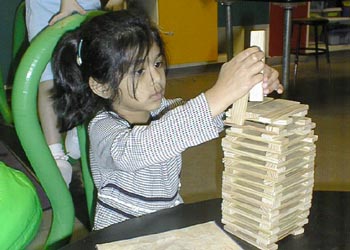![[Metroactive News&Issues]](http://metroactive.com/gifs/news468.gif)
[ San Jose | Metroactive Central | Archives ]
Zoom Boom
Children's Discovery Museum merges two generations, and one of them doesn't even know it
By Jim Rendon
FIVE-YEAR-OLD Kaitlin Putney glues tiny pieces of torn construction paper to a card, making a multicolored circle. With the help of her mom, Kathy, she explains that she's making a mosaic. When she's done, she can drop the card in an oversize mailbox at the Children's Discovery Museum and the card will make its way to a ZIP Code that many people remember almost instinctively, even if they're not quite sure why: 02134.
For a generation of kids growing up in the 1970s, that ZIP Code along with a certain theme song, "come on and zoom, zoom, zooma, zoom," are an unforgettable part of their television coming of age.
Kaitlin's mother, Kathy, evens sings a bit of the tune as she sits in the ZOOMzone at San Jose's Children's Discovery Museum. This corner of the museum is part of the new ZOOM, a remake of the old '70s PBS show 20 years after it went off the air.
The original ZOOM, which premiered in 1972, was hosted by seven kids ranging in age from 9 to 13. The show took most of its direction from audience suggestion, and the child hosts were not so much actors as they were just everyday kids playing themselves on TV.
The show featured short documentaries based on viewer suggestions, joke- and story-telling, and ZOOMplays written by viewers and acted out by cast members. Kids spoke Ubbi-Dubbi, a language along the lines of pig Latin created by putting an "ub" after every pronounced vowel.
"I see the parents' eyes light up as soon as they see the ZOOM sign," says Karen Peck, the museum's outreach coordinator. "Some of them still remember how to speak Ubbi-Dubbi," she says, admitting under her breath that as a kid she never really got the hang of it.
San Jose's ZOOMzone was one of the first in the country and is part of a national tie-in to the Boston-based PBS show. The producers wanted to create a place where children could follow along with the experiments on TV and, ultimately, a place where segments could be taped and mailed into the show.
Peck says that KTEH films two ZOOM segments a year starring local kids. They are sent into ZOOM and some even make it on air. As with the old show, lots of audience participation is expected. Kids are even encouraged to turn off their TVs to do activities from the show. Children at the museum mail in suggestions for experiments, poems and drawings. And in two weeks, when the facility is remodeled, they will also be able to send email.
But for a lot of parents, the ZOOMzone is just a great place to let their kids run free.
"It's not a Chuck E. Cheese with tokens and incentives for toys and junk," says Putney as she watches her daughter root through strips of paper.
ZOOM's rebirth is less about latching onto the retro '70s trend that has permeated every nook of American culture than it is about reviving a successful idea. ZOOM was one of a crop of PBS shows that nursed a generation of Gen- Xers through their early years. These shows, like Electric Company and Sesame Street, were born from the idealism of the '60s but lived in the bell bottoms of the following decade. In the name of cultural purity, ZOOM precluded its cast members from making any television appearance for three years after they left the show and they were barred from doing commercials for three years, virtually guaranteeing their demise as a commodity.
The show got by with minimal scripting, and the best ideas were generated not by a ratings-driven writing staff but instead by submissions from kids around the country. At its peak, the show received 20,000 letters a week.
Of course, it's not the same show. Gone are the purple-and-yellow-striped shirts and the old ZOOM block letters that look as if they were pulled from the pages of a DC comic book. The songs are updated with guitar solos. There is an Ubbi-Dubbi rap and the whole show has much more of a science bent to it--something that Peck says makes it a great fit with Silicon Valley.
In this era of product tie-ins, money-making opportunities are never lost. On a high shelf in the museum gift store are a stack of ZOOM kits that teach kids how to make things like soap and night lights.
Even the mail song has had a few changes. It now urges kids to check out ZOOM's web page at www.pbs.org. But as in the past, the show will continue to imprint a certain Boston ZIP Code on a whole new generation. "Oh two one three four: Send it to ZOOM!"
[ San Jose | Metroactive Central | Archives ]
Copyright © 1999 Metro Publishing Inc. Metroactive is affiliated with the Boulevards Network.
For more information about the San Jose/Silicon Valley area, visit sanjose.com.
![]()

From the February 3-9, 2000 issue of Metro, Silicon Valley's Weekly Newspaper.